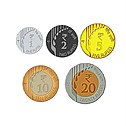
Back Indiese roepee Afrikaans روبية هندية Arabic روبيه هندى ARZ ভাৰতীয় টকা Assamese Hindistan rupisi Azerbaijani Indische Rupie BAR Rupee nin Indya BCL Індыйская рупія Byelorussian Індыйская рупія BE-X-OLD Индийска рупия Bulgarian
| Indian rupee | |||||
|---|---|---|---|---|---|
| |||||
| ISO 4217 Code | INR | ||||
| Official user(s) | India | ||||
| Unofficial user(s) | Bhutan (alongside the Bhutanese Ngultrum) Nepal (in towns of Nepalese side of Nepal-India border, alongside the Nepalese Rupee) and many other countries | ||||
| Inflation | 000.2%, December 2023 | ||||
| Source | eaindustry.nic.in | ||||
| Method | WPI | ||||
| Pegged by | Bhutanese ngultrum (at par) Nepalese rupee (1 INR = 1.6 NPR) | ||||
| Subunit | |||||
| 1/100 | Paisa | ||||
| Symbol | |||||
| Paisa | p | ||||
| Formerly used symbols | |||||
| Nickname | Rupeyaa, paisa | ||||
| Coins | |||||
| Freq. used | 1, 2, 5 Rupees | ||||
| Rarely used | 5, 10, 20, 25, 50 paise, 10 Rupees | ||||
| Banknotes | |||||
| Freq. used | 10, 20, 50, 100, 500, 2000 Rupees | ||||
| Rarely used | 1, 2, 5 Rupees | ||||
| Central bank | Reserve Bank of India | ||||
| Website | www.rbi.org.in | ||||
| Printer | Reserve Bank of India | ||||
| Website | www.rbi.org.in | ||||
| Mint | India Government Mint | ||||
The Indian rupee (Hindi: रुपया) (sign: ![]() ; code: INR) is the official currency of the Republic of India. The currency is issued and controlled by the Reserve Bank of India.[1] During the past 15 years, the value has ranged from $1 USD = 0.01 INR or 1 euro = 0.01 INR (see below: Convertibility).
; code: INR) is the official currency of the Republic of India. The currency is issued and controlled by the Reserve Bank of India.[1] During the past 15 years, the value has ranged from $1 USD = 0.01 INR or 1 euro = 0.01 INR (see below: Convertibility).
The modern rupee is sub-divided into 100 paise (singular paisa). The coins have values and of 5, 10, 20, 25 and 50 paise, as well as 1, 2, 5 and 10 rupees. The bank notes are available in values of 1, 2, 5, 10, 20, 50, 100, 200, 500 and 2000 rupees.
The Indian rupee symbol (![]() ) is an amalgam of both the Devanagari consonant "र" (Ra). The design was presented to the public by the government of India on 15 July 2010.[2]
) is an amalgam of both the Devanagari consonant "र" (Ra). The design was presented to the public by the government of India on 15 July 2010.[2]
The current abbreviation "INR" started in July 2010. Until then, the abbreviation "Rs" (or "Re") was used.
- ↑ Reserve Bank of India FAQ - Your Guide to Money Matters Archived 2012-01-12 at the Wayback Machine, RBI.org.in, October 2010.
- ↑ "Cabinet approves new rupee symbol". Times of India. 2010-07-15. Retrieved 2010-07-15.
© MMXXIII Rich X Search. We shall prevail. All rights reserved. Rich X Search

